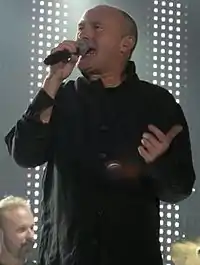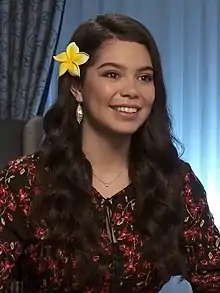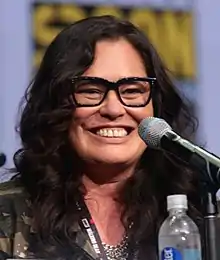Disney Character Voices International
Disney Character Voices International, Inc. is a subsidiary of The Walt Disney Company with primary responsibility for the provision of translation and dubbing services for all Disney productions including those by Walt Disney Studios Motion Pictures, Disney Music Group, and Disney Media Distribution. This division also supervises dubbings for Disney theme parks and derived games. An office of the division is present in several countries around the world.[1][2]
| Type | Subsidiary |
|---|---|
| Founded | 1988 |
| Founder | Michael Eisner |
| Headquarters | Burbank, California, United States |
| Owner | The Walt Disney Company |
History

The first dubbing issued for a Disney movie was Snow White and the Seven Dwarfs, which was originally distributed in 1938 in various Western languages. Walt Disney expressed to Tatiana Angelini, Swedish voice of Snow White, that she was his personal favorite international voice for the character.[3] The movie premiered at the 6th Venice International Film Festival, winning the Grand Art Trophy special award.[4] Disney was unable to secure distribution in Nazi Germany. To make a German-language version for Austria and Switzerland, Disney recorded native German voice talent in Amsterdam.[5][6][7]
In the 40s, Jimmy Johnson named Jack Cutting, Disney animator since 1930, responsible for the dubbing of Disney movies foreign languages.[8] In 1948, Disney received a Special Achievement Award at the 5th Golden Globe Awards for succeeding in producing a Hindustani dubbing of Bambi right after the end of the Indian independence movement, for "furthering the (American) influence of the screen".[9][10] While Bambi was the first movie to be dubbed in Hindustani, it is unknown whether more movies followed, or if the next dubbings produced by Disney India had to wait for Aladdin to be released in 1994 in Hindi, Tamil and Telugu.[11] The DCVI affiliate branch itself was founded in January 1988, when Michael Eisner decided to set up a dubbing department, directed by Roy Disney.[12]
Cast selection

To keep the whole production under control, Disney established a centralized system to hold auditions from actors all over the world, which gained the Walt Disney Company the 2017 Technology and Engineering Emmy Awards.[2][13] Rick Dempsey, Senior Vice President of DCVI, said he specifically makes the casting decisions for countries that make the top 14 percent of the box office, which sets the blueprint of the character’s voice with the director of the particular language hub. Local offices placed in countries whose voices are directly selected by DCVI will have competence over a specific geographical area, and they will cast the rest of the region in comparison to the selected voices. According to Dempsey, the voices do not have to be identical to the original English voices, but they must match the character, letting them shine through. Especially since 2000s, local celebrities can sometimes be chosen for their appeal to their respective market more than their ability to match or accentuate the character, to make the movie more appealing to the local audience.[2]
Languages
Disney movies are usually released in theaters in a set of languages, which varies depending on the product. All Disney animated movies are systematically dubbed and distributed in a fixed group of languages. However, there are languages covered by the department on an irregular base, which varies depending on the movie.
Dubbings systematically released
Over the years, the set of languages covered by DCVI has expanded, with a typical animated tentpole being nowadays distributed in theaters in 39 to 43 territories, an average live-action movie numbering 12 to 15 languages, and a four-quadrant live-action film like Pirates of the Caribbean being dubbed into about 27 tongues.[14] The number of languages involved in the dubbing process varies in accordance with the kind of product, with animation movies covering the largest number, and it has expanded throughout the years.
Dubbings irregularly or occasionally released


Moana was released in 2016, which received a total of three special dubbings in Polynesian languages in the space of two years from its original release date.[15][16][17][18][19] Following upon the success of these three productions, a special Northern Sami dubbing was also made for the movie Frozen II, while no dubbing in this language was made for the first chapter of the series.[20][21] A peculiar case in one-time dubbings are the Arapaho version of Bambi, released in 1994, and the Navajo version of Finding Nemo, released in 2016, made in collaboration with the Wyoming Indian Schools and the Navajo Nation Museum respectively.[22][23] Differently from the rest of special dubbings, these two movies are not linked in any ways to the Arapaho and Navajo cultures, but they were rather chosen as a means to preserve these two languages, teaching them to young generations through a popular Disney movie.[24][25][26] But while the Navajo version of Finding Nemo is a complete dubbing, which includes even a Navajo version of the end-credits song "Beyond the Sea" performed by Fall Out Boy's lead singer Patrick Stump, the Arapaho version of Bambi is only a partial dubbing, where the spoken parts were dubbed, but the songs were all left in English.[22][23]
References
- "With Disney Character Voices International (Sorted by Popularity Ascending)". IMDb. Retrieved 2020-06-01.
- "Meet Rick Dempsey". disneyexaminer.com. Retrieved 2017-04-08.
- "Snövits röst har tystnat". www.expressen.se (in Swedish). Retrieved 2020-06-01.
- "ASAC Dati: Ricerca avanzata film". asac.labiennale.org. Retrieved 2020-06-01.
- "ANNO, Österreichische Film-Zeitung, 1938-01-07, Seite 2". anno.onb.ac.at. Retrieved 2020-06-01.
- "Sneeuwwitje en de Zeven Dwergen (1937) | Bioscoopfilms | TelevisieGeheugen". www.televisiegeheugen.nl. Retrieved 2020-12-08.
- DFF Deutsches Filminstitut & Filmmuseum (August 20, 2020). "SCHNEEWITTCHEN in drei Synchronfassungen // Vortrag von Prof. Dr. Joseph Garncarz". YouTube.
- "Jack Cutting Speaks". www.mouseplanet.com. Retrieved 2020-12-08.
- "Walt Disney". www.goldenglobes.com. Retrieved 2020-07-18.
- "Golden Globes, USA (1948)". IMDb. Retrieved 2020-07-18.
- Team, AnimationXpress (2004-10-26). "The art of directing dubs: A chat with Ellie Lewis". AnimationXpress. Retrieved 2020-07-18.
- "Making Movie Magic in Any Language". D23. 2016-12-16. Retrieved 2020-06-01.
- "The Walt Disney Company Receives 2017 Technology & Engineering Emmy Award". Television Academy. Retrieved 2020-06-01.
- "Inside the Weird World of International Dubbing". The Hollywood Reporter. Retrieved 2020-06-01.
- "'Moana' to be First Disney Film Translated Into Tahitian Language". Entertainment Weekly's EW.com. Retrieved 2016-11-14.
- "Moana in Māori hits the big screen". RNZ. 2017-09-11. Retrieved 2020-06-02.
- Speak Māori (2017-06-08), Te Reo Māori Moana Casting, retrieved 2017-07-14
- "Disney's Moana to make World Premiere in ʻŌlelo Hawaiʻi at Ko Olina's World Oceans Day, June 10". Ko Olina. Retrieved 2020-06-02.
- "Moana Hawaiian Translation Project | Academy for Creative Media System". Academy for Creative Media System. 2017-08-08. Archived from the original on 2017-11-01. Retrieved 2017-11-05.
- Milligan, Mercedes (2019-07-19). "'Frozen 2' Will Get Sámi Language Version". Animation Magazine. Retrieved 2019-07-27.
- Idivuoma, Mariela (2019-11-20). "Dette er de samiske Disney-stjernene". NRK. Retrieved 2020-06-02.
- Wiles, Sara (2005-08-15). "Walt Disney's Bambi – The Arapaho Language Version". Tribal College Journal of American Indian Higher Education. Retrieved 2020-12-06.
- "Making Movie Magic in Any Language". D23. 2016-12-16. Retrieved 2020-12-08.
- Wall Street Journal. "Navajo Version of 'Finding Nemo' Aims to Promote Language". YouTube.
- Hinton, Leanne (1996). "Review of Bambi: The Arapaho Language Version". International Journal of American Linguistics. 62 (2): 210–214. ISSN 0020-7071.
- "Navajo Version of 'Finding Nemo' Aims to Promote Language", YouTube, 2014-12-22, retrieved 2014-12-22
External links
- Disney Character Voices International at IMDb (U.S. branch only)